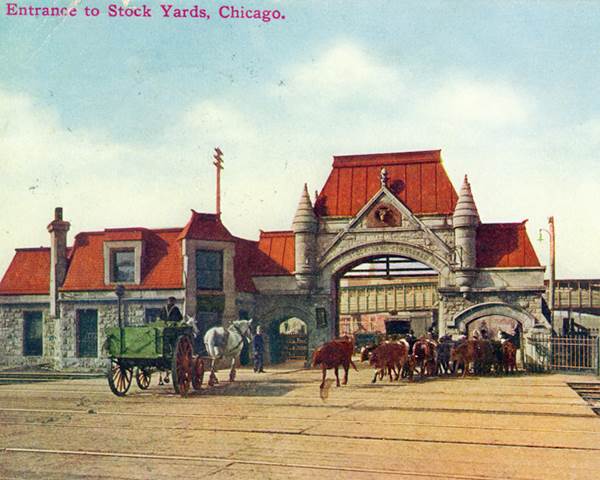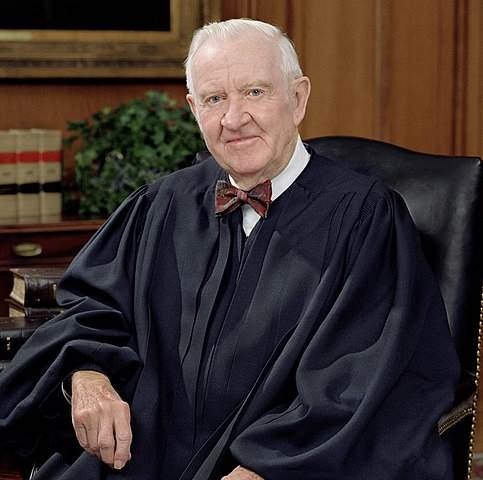By Dr. Jacob Friefeld
They brought about ten thousand head of cattle every day, and as many hogs, and half as many sheep — which meant some eight or ten million live creatures turned into food every year. One stood and watched, and little by little caught the drift of the tide, as it set in the direction of the packing houses. There were groups of cattle being driven to the chutes, which were roadways about fifteen feet wide, raised high above the pens. In these chutes the stream of animals was continuous; it was quite uncanny to watch them, pressing on to their fate, all unsuspicious a very river of death.
— Upton Sinclair, The Jungle
On December 25, 1865, the Chicago Union Stock Yards opened. By the turn of the century they provided 25,000 jobs to Chicagoans involved in the meatpacking industry and helped make Chicago the center of the Midwestern economy.
The Union Stock Yards were a marvel of modernity. Before industrialization, most American men could expect independence or self-employment either as farmers, lawyers, or in some other trade. Americans saw that expectation gradually disappear during the 1800s, replaced by corporations and wage labor — replaced by a modern economy.
Before modernization, Chicago’s small stock yards, where cattle would arrive in Chicago and await slaughter, had been spread throughout the city. The modern impulse toward consolidation inspired nine railroad companies to purchase land on the city’s South Side and consolidate the stock yards into a single forty-acre operation.
 The famous arched entry to the Union Stock Yards, as shown in a 1910 postcard.
The famous arched entry to the Union Stock Yards, as shown in a 1910 postcard.
This consolidation encouraged further reorganization as major meatpacking companies relocated to be near the new Union Stock Yards. What resulted was a perfect assembly line of carnage. As one English visitor writing for The Times of London put it:
The steers are driven into long pens, and an expert rifleman, walking upon a platform over them, discharges a rifle shot into the brain just behind the horns. The killing is instantaneous, the steer, without even a groan, falling like a log. The animal is then drawn forward from the pen, the hide quickly removed, and the carcass prepared and cut up ready for storage in the “chill rooms” and subsequent shipment.
By 1900, Chicago supplied Americans with over 80% of their beef and pork, but it wasn’t just meat that made Chicago an economic marvel. Railroads that connected prairie farms to the city allowed farmers to send their grain with speed to Chicago overland rather than by river to New Orleans. The grain elevators, giant storehouses where grain was stored and then shipped from, could load and unload grain to and from ships and trains at a rate of about 24,000 bushels per hour. As historian William Cronon asserts, when all of the city’s grain elevators operated at capacity, they received and shipped about 500,000 bushels every ten hours.
Beef, pork, and grain poured into Chicago on Lake Michigan and its railroads, along with lumber and the people whose labor was necessary to slaughter, move, and cut it. In the process, cattle, grain, and trees were turned from the simple tools of subsistence and homebuilding into commodities, or products to be traded and shipped throughout the country. The Union stockyards helped make Chicago an economic powerhouse but also signaled how the world — and the way humans used its gifts — was changing.
Also this month in Illinois History …
- December 3, 1818: The United States admitted Illinois as the Union’s twenty-first state.
- December 6, 1847: Abraham Lincoln took his seat in the Illinois House of Representatives.
- December 19, 1975: Illinoisan John Paul Stevens was sworn in as a Supreme Court justice.
 John Paul Stevens in 2006
John Paul Stevens in 2006
Jacob Friefeld is an ALPLM research historian specializing in Illinois and Midwest history.